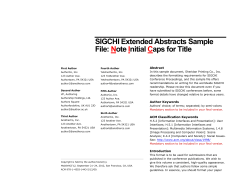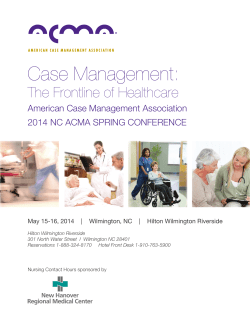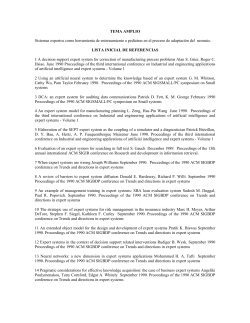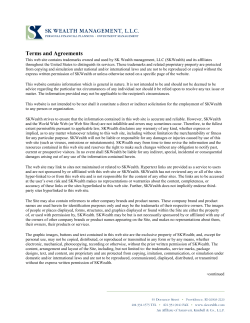
Author Instructions for Papers and Abstracts 1 Introduction Stephen Spencer
Author Instructions for Papers and Abstracts
Stephen Spencer∗
The University of Washington
1
Introduction
This document provides information and links to external resources to authors preparing content for presentation at an ACM
SIGGRAPH-sponsored event. Your content may be a one-page abstract, a short paper or technical brief, or a full-length technical
paper; the formatting guidelines are very nearly identical. The differences are few, and clearly identified.
2
Glossary of Terms
There are a number of terms that will be used in this document. You
probably know most of them, or have at least heard of them, but it’s
good to have clear definitions.
to prepare your abstract or paper. The formatting will be taken care
of for you with this LATEX class. We do not require that you use
LATEX, though most do.
http://www.siggraph.org/sites/default/files/acmsiggraph.zip
The archive file contains the LATEX and B IBTEX class files, Makefiles for preparing a PDF from the LATEX source file, a template
source file, and formatted example PDF.
3.1
General Organization
Your paper should include the following elements, in this order:
• title and author information
ACM SIGGRAPH’s parent organization, the Association for
Computing Machinery.
• abstract
SIGGRAPH Our flagship conference, held annually in North
America. Also the name of our parent organization. (SIGGRAPH = Special Interest Group on Computer Graphics and
Interactive Techniques)
• keywords
SIGGRAPH Asia Our other flagship conference, held annually in
Southeast Asia.
sponsored event A conference, workshop or symposium that has
the financial backing of the SIGGRAPH organization. In the
context of this document, it is an event that is not one of our
two flagship conferences.
copyright form A document completed by authors of technical
papers accepted to our flagship conferences or our other sponsored events.
license form A document completed by authors of technical papers accepted to our flagship conferences or our other sponsored events.
permission and release form A document completed by authors
of abstracts of content accepted to our flagship conferences or
our other sponsored events.
auxiliary material Material prepared by the contributor, in addition to their primary piece of content (paper, abstract, poster,
etc.) which is distributed with that content and which helps to
illustrate the concepts presented. Still images and movies are
the most-often supplied types of auxiliary material.
third-party content Any content used in an abstract, paper, or
auxiliary material not created by the authors.
ACM Digital Library (or just “DL”) The primary repository for
material published by ACM. http://www.acm.org/dl
3
Formatting Your Content
The specifications and descriptions in this document are sufficient
for preparing an acceptable abstract or paper.
It is strongly recommended that you use the “acmsiggraph” LATEX
class, available from the following link, and the LATEX application
∗ e-mail:
spencer@cs.washington.edu
• CR Categories
• hyperlinked icons
• body of the paper
• references
The template source file - the “template.tex” file - should be closely
examined, especially the preamble; there are several important definitions you must make that are specific to your paper. Two versions of this example file are included in the “acmsiggraph.zip”
archive; “template.annotated.tex” contains copious documentation
of each of the commands and definitions specific to the “acmsiggraph” LATEX class, and “template.tex” is clear of that documentation. The code in each file, however, is identical.
If you are preparing an abstract, the “keywords” and “CR categories” are optional. The “hyperlinked icons” are only to be used in
papers accepted to our annual conferences. Papers and “technical
briefs” (short papers) should include all of these elements, except
the hyperlinked icons.
3.2
Formatting Requirements
• page size: 8.5 inches by 11.0 inches (US Letter)
• top margin: 0.75 inch
• bottom margin: 1.0 inch
• left margin: 0.75 inch
• right margin: 0.75 inch
• number of columns: 2
• column height: 9.25 inches
• column width: 3.33 inches
• space between columns (gutter): 0.34 inch
• vertical space between paragraphs: 10pt
• paragraph indentation: none
• copyright space: varies (see below)
• title and author text: centered above the two columns of body
text
Figure 1 provides a visual reference to the two parameters and the
space left clear as a result of using each of the parameters.
Please do not include page numbers in your paper or abstract; they
will be added during production, once the content has been ordered
according to the final program for the event.
Important: if you are using LATEX , you must include
the “\copyrightspace” command immediately before the first
“\section” command in your paper. The example LATEX file - “template.tex” - illustrates this command’s placement, and the command, when executed, will use the amount of space defined by each
of the two possible parameters.
3.3
Typeface Requirements
• body text: 9-point serif (Times, etc.) on 10-point leading (line
spacing)
• title: 14-point sans-serif (Helvetica, etc.) on 18-point leading
• authors and affiliations: 10-point serif on 12-point leading
• section heading: 10-point bold sans-serif, numbered (“1”)
• subsection heading:
(“1.2”)
10-point bold sans-serif, numbered
• subsubsection heading: 10-point italic sans-serif, numbered
(“1.2.1”)
• caption label: 9-point bold serif
• caption text: 9-point italic serif
• references: 9-point serif on 10-point leading, 2em indent for
second and subsequent lines, author names in “S MALL C APS”
Important: All typefaces used in your document must be embedded
in your PDF.
Important: Adjustment of the typeface size and style, line spacing,
paragraph spacing and indentation, and margins is prohibited.
3.4
“Bibstrip” Space
The amount of space to leave for the “bibstrip” - the copyright or
license or permission notice - is one of the few differences in formatting among the varying kinds of content.
If you are preparing a paper (long or short) or one- to several-page
abstract as the primary documentation of your presentation at an
ACM SIGGRAPH-sponsored event, you must leave space clear at
the base of the left column for a block of text that is added during
production.
This block of text is the copyright notice or the license notice or the
permission notice, as appropriate for your content.
This block of text, for most types of content, must be one inch
tall (see Figure 1). The exception to the height of the space is for
technical papers accepted to one of our two flagship events, and to
be published in the ACM “Transactions on Graphics” journal; the
space for that type of content must be 1.5 inches tall.
If your paper has been accepted for presentation at one of our annual conferences, and will be published in an issue of the ACM
“Transactions on Graphics” journal, the space must be 1.5 inches
tall.
The “tog” parameter to the “\documentclass” command at the top
of your LATEXfile will produce a 1.5-inch blank space at the base of
the left column on the first page of your document:
If you are using some other application to prepare your paper or
abstract, you may wish to prepare your content without that space,
and insert a column break at the appropriate place. The amount of
blank space is measured from the bottom of the column of text, not
from the bottom of the page.
If you are at all unsure about how much space to leave clear, please
ask. This issue, and typeface embedding, are the most common
issues that authors must address after delivering their final content
and they are checked during the production phase.
3.5
Title, Authors, and Affiliations
The title and author information for your paper should be centered
across the top of the (first) page, and should include full names,
company or institutional affiliation, and e-mail address.
Capitalize the title of your paper in an appropriate manner. Rules
for capitalization can be found at the following link:
http://www.grammarbook.com/punctuation/capital.asp
To illustrate, here are three examples:
No. EXPLORING MOBILE EYE-TRACKING FOR OBSERVATIONAL RESEARCH ON THE FLIGHT DECK
No. Exploring mobile eye-tracking for observational research on
the flight deck
Yes. Exploring Mobile Eye-Tracking for Observational Research
on the Flight Deck
3.6
Keywords and CR Categories
Your paper should have appropriate keywords and CR categories,
which will be used to index the paper in various online databases,
and helps others to find your paper.
Keywords are user-selected, and should describe the major topics of
your paper - radiosity, global illumination, graphcut, filtering, etc.
CR categories are ACM’s official classification system, and the
complete list of the categories is available from the following link:
http://www.acm.org/about/class/1998/
(Computer Graphics is “I.3” - that’s a good starting place.)
The “acmsiggraph” LATEX class, and the sample LATEX document
provided with it have commands which assist in the definition and
formatting of keywords and CR categories:
• \keywords{} allows the comma-separated list of keywords
• the \keywordlist command prints out the keywords
\documentclass[tog]{acmsiggraph}
The “conference” parameter to the “\documentclass” command at
the top of your LATEXfile will produce a 1.0-inch blank space at the
base of the left column on the first page of your document:
\documentclass[conference]{acmsiggraph}
• \CRcat{} allows the hierarchical definition of a CR category
specific to your content
• the \CRcatlist{} environment collects and prints the defined
categories
Figure 1: Illustration of varying amounts of space left clear for the ACM “bibstrip”, for the two possible parameters given to the
“\documentclass” command. Left is “tog,” and right is “conference.”
3.7
Annual Conference Paper Hyperlinks
If your paper has been accepted for presentation at one of our two
annual conferences - SIGGRAPH or SIGGRAPH Asia - and it will
be published in an issue of the ACM “Transactions on Graphics”
journal, there are hyperlinked icons that should be included in your
paper.
These hyperlinked icons were introduced in 2011, and provide
quick links from the electronic version of a technical paper to the
ACM DL page for that paper, as well as to author-provided auxiliary material.
• hyperlinks: for the “DL” icon, please use this link, where “X”
is the article DOI you received:
http://doi.acm.org/10.1145/X
• hyperlinks: for the “PDF” icon, please use this link, where
“Y” is the second set of seven digits from the article DOI:
http://portal.acm.org/ft gateway.cfm?id=Y&type=pdf
• hyperlinks: if you wish to use any of the other hyperlink icons,
you should provide links to your own resources.
An example of a properly-formatted list of hyperlinked icons is
shown in the figure below.
After your paper has been accepted, and before the due date of your
paper, you will receive the “article DOI” for your paper, a numeric
code which will point the reader to the ACM DL page for your
paper. This numeric code will have seven digits, a period, and seven
more digits.
The “acmsiggraph” LATEX class includes this functionality. Please
example the “template.tex” file, looking at the “\TOG” definitions in the preamble of the document, and the placement of the
“\TOGlinkslist” command.
If you are using another program to prepare your final paper, and
need to include the hyperlinked icons, you should follow these instructions:
• position: Just before the first section of the body of your paper
• size: approximately 0.13 inch tall
• typeface: 9-point serif S MALL C APS style, with “Links:” set
in bold.
• labels: please use “DL,” “PDF,” “Web,” “Video,” “Data,” and
“Code” for the labels.
Figure 2: Visual example of hyperlinked icons for annual conference papers.
The “DL” and “PDF” hyperlink icons are required for annual conference papers. The other hyperlink icons are optional.
If your technical paper is not being published in the ACM “Transactions on Graphics” journal, you should not be using these hyperlinked icons.
3.8
Figures and Tables
Color and gray-scale figures in your paper should be prepared as
300 dpi TIFF or EPS files, using the CMYK color space. The JPEG
format is lossy, and is not recommended for high-quality image reproduction.
If you have text in your figures or tables, please make sure the application that created them embeds the typeface(s) used in them.
Captions for figures should be placed underneath the figure.
Captions for tables should be placed above the table.
4
Third-Party Content
Third-party content is, as is stated in the glossary of terms, “any
content used in an abstract, paper, or auxiliary material not created
by the authors.”
If you are going to use third-party material in your content, you will
need to make sure you have permission to use that material, identify
the material in the paper and on the copyright form, and deliver documentation of the permission you received to ACM, accompanying
your copyright form.
ACM’s policy and procedures for handling third-party material can
be found at the following link:
http://www.acm.org/publications/third-party-material
5
“Artistic Images” and Copyright Transfer
ACM’s copyright policy mandates that copyright for the paper and
its contents - third-party content aside - by transferred to ACM as a
condition of publication.
When the last name of the author is used in the text, it may be
omitted from the citation, leaving only the year - “...as shown in
Fedkiw et al. [2001], the coefficient remains...”
LATEX users can use “\cite{citekey}” to produce the longer citation form, and “\shortcite{citekey}” to produce the shorter citation
form.
6.2
References
The reference list, or bibliography, must be unnumbered, alphabetized by primary author’s last name, with the authors’ names set in
small caps, followed by the year of publication, followed by other
information. The page number, if any, appears last in the reference.
Author names are arranged as “last name, initials.” The second
and successive lines of a reference are indented by 2em. Journal,
book, thesis, and conference proceedings titles, as well as journal
volumes, are set in italic serif type.
The “acmsiggraph” B IBTEX class faithfully implements these specifications, and the reference list at the conclusion of the “template.pdf” document illustrates the specifications.
Please note: adjustment of the typeface size and style, line spacing,
paragraph spacing, indentation, or margins is not permitted.
6.3
SIGGRAPH Papers
References to papers presented at our flagship conferences - SIGGRAPH and SIGGRAPH Asia - should be prepared in the following manner: the conference name - “SIGGRAPH’ or “SIGGRAPH
Asia” - followed by a single space, and then either the last two
digits of the calendar year if the conference was held prior to the
year 2000, and all four digits of the calendar year if the conference
was held in 2000 or later. Please capitalize the term “SIGGRAPH.”
Please do not include an apostrophe before two-digit year designations.
http://www.acm.org/publications/policies/copyright policy
An exception is allowed for images or figures in your content which
have “. . . independent artistic value.” You or your employer may
retain copyright to those images or figures which you created for
some purpose other than to illustrate a point in the content, and
wish to exploit in other contexts.
(An example of this might be a still image from a Pixar film that
illustrates the research that you, as a Pixar employee, worked on
and helped to implement as part of the making of that film.)
Additionally, please note that in 1993, 2002, and again in 2007,
changes were made in the reference format, reflecting changes in
the ordering of the Proceedings Series, ACM’s partnership with the
ACM Transactions on Graphics journal, and finally, ACM’s “Online First” initiative. More information on this initiative can be
found at the following link:
http://doi.acm.org/10.1145/1284621.1284637
7
PDF Document Preparation
If your content has such exceptional images, you must grant ACM
permission to use them in the context of your content in current
and future formats, identify them on the copyright form and in the
content itself, by including the owner’s copyright notice within the
image itself and/or in the figure’s caption.
The printed and electronic documentation for our sponsored events
are prepared from Adobe Acrobat PDF documents. This is the format in which your final content should be delivered. (Auxiliary
material, discussed in the next section, is a separate issue.)
6
Extenuating circumstances may necessitate the delivery of your final content in some other format - PostScript or Word, for example
- but this will be done on a case-by-case basis.
6.1
Citations and References
Citations
The ACM SIGGRAPH citation format is the familiar “author year”
format. The year is separated from the author by a single space [Yee 2000]. If the article has two authors, their last names are used,
separated by the word “and” - [Lennon and McCartney 1964]. If
the article has three or more authors, the primary author’s last name,
followed by “et al.” are used - [Fedkiw et al. 2001].
Multiple citations at a single point in the document are separated by
semicolons - [Fedkiw et al. 2001; Yee 2000].
The method you choose to prepare the PDF version of your final
content is your decision. There are several methods that are commonly used:
(LATEX) dvips and ps2pdf This workflow is several steps but is robust.
This command converts a LATEX ”.dvi” file to PostScript, with
scalable Type 1 typefaces, with a ”US Letter” (8.5 inches by
11 inches) page size.
dvips -Ppdf -G0 -t letter -o paper.ps paper.dvi
This command converts a PostScript file to PDF, embedding
typefaces and not downsampling or subsampling the images
in the file during the conversion to PDF.
ps2pdf -dPDFSETTINGS=/prepress \
-dCompatibilityLevel=1.4 \
-dAutoFilterColorImages=false \
-dAutoFilterGrayImages=false \
-dColorImageFilter=/FlateEncode \
-dGrayImageFilter=/FlateEncode \
-dMonoImageFilter=/FlateEncode \
-dDownsampleColorImages=false \
-dDownsampleGrayImages=false \
paper.ps paper.pdf
(LATEX) pdftex and pdfLATEX This is a newer and more convenient workflow, though you may need to adjust one or more
configuration files in order to ensure that typefaces are properly embedded.
Googling “updmap embed typeface” will return lots of relevant results.
If you are on a Linux system, running the “updmap –edit”
command and ensuring that the parameter sent to “pdftexDownloadBase14” is“true” should be sufficient.
If you are on a Windows system, you’ll want to find your
“updmap.cf” file and make that change, if necessary, with a
text editor.
Adobe Acrobat This application integrates PDF creation into
many other applications, including Microsoft Word and
Adobe InDesign. You will want to install and use a specific
“job options” file which will embed typefaces. That file can
be found at the following link:
http://www.sheridanprinting.com/typedept/acm.joboptions
and should be installed into Adobe Acrobat Distiller from the
“Settings > Add Adobe PDF Settings” menu.
It is extremely important to note that all of the typefaces you use
in your document must be embedded in the PDF. This is an ACM
requirement for publication.
The Adobe Reader application can be used to verify the status of
typefaces in your PDF document; access the “File > Properties”
menu item, and then select the “Fonts” tab. Each typeface listed in
this window should have either “Embedded” or “Embedded Subset” next to it. If not, that typeface is not embedded.
The “pdffonts” application (Linux and Macintosh) can be used to
verify the status of typefaces in your PDF document; there should
be an “yes” in the “emb” column for each typeface. If not, that
typeface is not embedded.
8
Author-Prepared Versions of Final Content
ACM’s copyright policy provides for author-prepared versions of
final content to be made available on the author’s personal or employer’s website for distribution.
The author is responsible for creating the article-specific notice and
making it part of the PDF. Here is an example (your article-specific
notice would have the correct publication title, volume, number,
year, month, and ACM article DOI):
(c) 2009 ACM. This is the author’s version of the work.
It is posted here by permission of ACM for your personal
use. Not for redistribution. The definitive version was
published in ACM Transactions on Graphics 28(3),
August 2009. <http://doi.acm.org/10.1145/1576246.1531329>.
Adding this to an existing PDF document is not difficult to do. The
Adobe Acrobat Pro application has a “stamp tool” that can be used
for this purpose.
9
Auxiliary Material
Material accepted for presentation at an ACM SIGGRAPHsponsored event may be accompanied by material intended to enhance the presentation and understanding of the content. This “auxiliary” material - still images, animation files (Quicktime, AVI,
MPEG), etc. - will accompany the primary material in conference
deliverables (CD-ROM, USB stick) and in the ACM Digital Library.
Authors of technical papers accepted to our annual conferences
should know that the ”papers video” is now considered ”auxiliary”
material and should be delivered as or with the rest of your auxiliary
material.
Most sponsored events have an online conference management
system (SIS, “precisionconference.com,” etc.) which allows
for the uploading of auxiliary material. Should the CMS being used for an event not allow this, auxiliary material - or
a link to it - can be e-mailed directly to Stephen Spencer at
“spencer@cs.washington.edu.”
10
Resources
This document, the “acmsiggraph.zip” file, and numerous examples
are available from the following link:
http://www.siggraph.org/publications/instructions
11
Contact Information
If you have any questions about this document, or about the
preparation of your content, or have suggestions for improving this document, please let me know. My e-mail address is
“spencer@cs.washington.edu” and I can be reached by telephone
at +1-206-616-3281.
© Copyright 2025





















